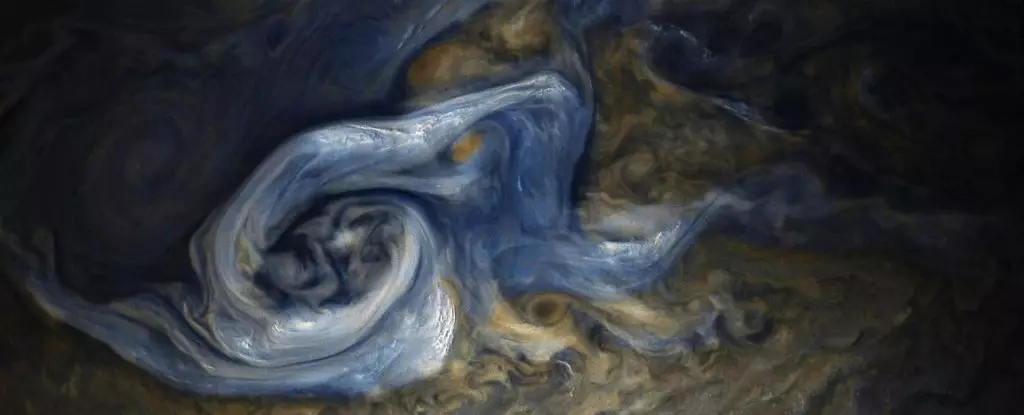Jupiter, the colossal giant of our Solar System, continues to captivate scientists and astronomers alike with its bizarre and tumultuous atmosphere. While many may imagine thunderous storms and swirling gases as phenomena exclusive to Earth, recent research sheds light on how Jupiter harbors an intricately complex weather system that bears striking resemblances, as well as stark contrasts, to terrestrial conditions. The latest revelation, involving the existence of so-called “mushballs”—unique formations of ice and ammonia—offers a glimpse into the strange reality of Jupiter’s meteorological processes and speaks volumes about the planet’s atmospheric chemistry.
The Birth of an Idea
The concept of mushballs is not a mere product of fantastical imagination; it emerged from meticulous analysis of data gathered by NASA’s Juno probe and further interpretations by researchers. Initially proposed in 2020, scientists posited that the immense storms on Jupiter do more than just create magnificent light displays; they play a pivotal role in the planet’s atmospheric dynamics. The idea is that these storms eject water vapor high into the atmosphere where, upon colliding with ammonia gas, unique icy formations are created. When scientists like Chris Moeckel from UC Berkeley engaged with these theories, skepticism was natural. After a fulsome three years of rigorous exploration, scientists found the hypothesis surprisingly robust, unveiling a new understanding of what fuels the atmospheric conditions we observe on this distant planet.
The Mushball Mystery
Mushballs, with their slushy consistency reminiscent of convenience store treats, stand at the center of a significant breakthrough in planetary science. According to researchers, these volcanic-like formations result from the intricate interplay of water and ammonia in Jupiter’s atmosphere. When the storms surge upwards, they encounter extreme temperatures that morph the ammonia into a liquid capable of mixing with water. Instead of simply dispersing, this concoction forms mushballs, which plummet into the planet’s depths, carrying ammonia with them. Such mechanisms clarify why scientists previously struggled to understand the patchy distribution of ammonia across the broader expanse of Jupiter’s atmosphere.
Delving Deep: A New Perspective
The atmospheric phenomena of giant planets such as Jupiter are characterized by their complexity and depth—literal and figurative. Traditional observations often focus on the beautiful yet chaotic surface-level activity, but Moeckel and his team challenge this view, revealing significant structures that extend well beyond the visible clouds. Their research highlights that atmospheric systems can reach depths of up to 150 kilometers (93 miles), a fact that oscillates the telescope into realms unviewed by many. By uncovering the layered dynamics of Jupiter’s storms, we shift our perspective from mere surface contemplation to an intricate understanding of the planet’s interior processes.
Furthermore, the processes that give rise to mushballs may not solely be confined to Jupiter. Scientists propose that similar phenomena might unfold across the giant planets of our Solar System—Saturn, Uranus, and Neptune could have their own versions of mushball storms altering their atmospheres. This tantalizing proposition invites future research, opening the door for comparative studies that could revolutionize our understanding of atmospheric science on a galactic scale.
A Challenge to Existing Theories
Moeckel’s findings also compel the scientific community to revisit fundamental theories about atmospheric interactions. The notion of mushballs challenges the existing frameworks of meteorological dynamics on gas giants, insisting that we must account for granular formations and their roles in chemical distribution and energy transfer within atmospheric layers. As one scientist noted, the “smoking gun” evidence gleaned from Juno’s data, which suggested a possible interaction linked to mushballs, adds weight to the argument that specific conditions must be met to allow such spectacular phenomena to exist.
Ultimately, these developments underline the importance of interdisciplinary collaborations, enabling astronomers not only to probe the atmospheres of distant celestial bodies but also to question our established scientific narratives. The work ahead will require meticulous attention to new data, creative thinking, and a willingness to entertain the unconventional.
Looking Ahead: An Invitation for Exploration
For those fascinated by outer space and atmospheric science, the ongoing studies of Jupiter’s weather provide an exhilarating preview of the questions yet to be answered. As research progresses and new technologies come online, the opportunity to explore the atmospheric mechanics of giant planets will surely expand. Understanding the nature of phenomena like mushball storms deepens our appreciation for the complexities of planetary weather, potentially leading us toward groundbreaking revelations about not just Jupiter, but the many worlds that share our galaxy. The narrative around these discoveries is far from finished, and each new finding propels us towards a more profound understanding of our universe.


Leave a Reply